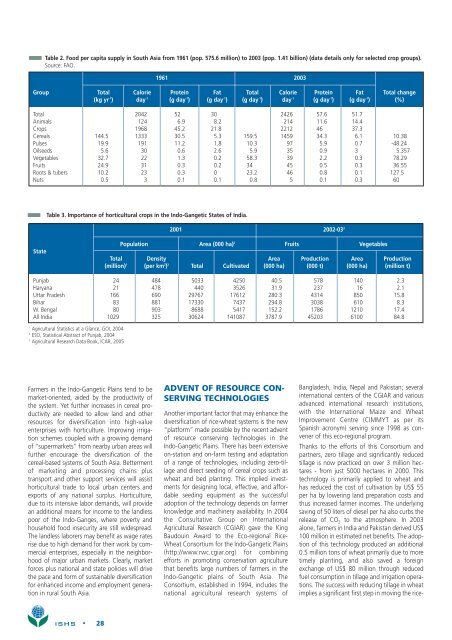Acta Horticulturae
Acta Horticulturae
Acta Horticulturae
Create successful ePaper yourself
Turn your PDF publications into a flip-book with our unique Google optimized e-Paper software.
Table 2. Food per capita supply in South Asia from 1961 (pop. 575.6 million) to 2003 (pop. 1.41 billion) (data details only for selected crop groups).<br />
Source: FAO.<br />
1961 2003<br />
Group Total Calorie Protein Fat Total Calorie Protein Fat Total change<br />
(kg yr -1 ) day -1 (g day -1 ) (g day -1 ) (g day -1 ) day -1 (g day -1 ) (g day -1 ) (%)<br />
Total 2042 52 30 2426 57.6 51.7<br />
Animals 124 6.9 8.2 214 11.6 14.4<br />
Crops 1968 45.2 21.8 2212 46 37.3<br />
Cereals 144.5 1333 30.5 5.3 159.5 1459 34.3 6.1 10.38<br />
Pulses 19.9 191 11.2 1.8 10.3 97 5.9 0.7 -48.24<br />
Oilseeds 5.6 30 0.6 2.6 5.9 35 0.9 3 5.357<br />
Vegetables 32.7 22 1.3 0.2 58.3 39 2.2 0.3 78.29<br />
Fruits 24.9 31 0.3 0.2 34 45 0.5 0.3 36.55<br />
Roots & tubers 10.2 23 0.3 0 23.2 46 0.8 0.1 127.5<br />
Nuts 0.5 3 0.1 0.1 0.8 5 0.1 0.3 60<br />
Table 3. Importance of horticultural crops in the Indo-Gangetic States of India.<br />
2001 2002-03 3<br />
State<br />
Population Area (000 ha) 2 Fruits Vegetables<br />
Total Density Area Production Area Production<br />
(million) 1 (per km 2 ) 2 Total Cultivated (000 ha) (000 t) (000 ha) (million t)<br />
Punjab 24 484 5033 4250 40.5 578 140 2.3<br />
Haryana 21 478 440 3526 31.9 237 16 2.1<br />
Uttar Pradesh 166 690 29767 17612 280.3 4314 850 15.8<br />
Bihar 83 881 17330 7437 294.8 3038 610 8.3<br />
W. Bengal 80 903 8688 5417 152.2 1786 1210 17.4<br />
All India 1029 325 30624 141087 3787.9 45203 6100 84.8<br />
1<br />
Agricultural Statistics at a Glance, GOI, 2004<br />
2<br />
ESO, Statistical Abstract of Punjab, 2004<br />
3<br />
Agricultural Research Data Book, ICAR, 2005<br />
Farmers in the Indo-Gangetic Plains tend to be<br />
market-oriented, aided by the productivity of<br />
the system. Yet further increases in cereal productivity<br />
are needed to allow land and other<br />
resources for diversification into high-value<br />
enterprises with horticulture. Improving irrigation<br />
schemes coupled with a growing demand<br />
of “supermarkets” from nearby urban areas will<br />
further encourage the diversification of the<br />
cereal-based systems of South Asia. Betterment<br />
of marketing and processing chains plus<br />
transport and other support services will assist<br />
horticultural trade to local urban centers and<br />
exports of any national surplus. Horticulture,<br />
due to its intensive labor demands, will provide<br />
an additional means for income to the landless<br />
poor of the Indo-Ganges, where poverty and<br />
household food insecurity are still widespread.<br />
The landless laborers may benefit as wage rates<br />
rise due to high demand for their work by commercial<br />
enterprises, especially in the neighborhood<br />
of major urban markets. Clearly, market<br />
forces plus national and state policies will drive<br />
the pace and form of sustainable diversification<br />
for enhanced income and employment generation<br />
in rural South Asia.<br />
ADVENT OF RESOURCE CON-<br />
SERVING TECHNOLOGIES<br />
Another important factor that may enhance the<br />
diversification of rice-wheat systems is the new<br />
“platform” made possible by the recent advent<br />
of resource conserving technologies in the<br />
Indo-Gangetic Plains. There has been extensive<br />
on-station and on-farm testing and adaptation<br />
of a range of technologies, including zero-tillage<br />
and direct seeding of cereal crops such as<br />
wheat and bed planting. This implied investments<br />
for designing local, effective, and affordable<br />
seeding equipment as the successful<br />
adoption of the technology depends on farmer<br />
knowledge and machinery availability. In 2004<br />
the Consultative Group on International<br />
Agricultural Research (CGIAR) gave the King<br />
Baudouin Award to the Eco-regional Rice-<br />
Wheat Consortium for the Indo-Gangetic Plains<br />
(http://www.rwc.cgiar.org) for combining<br />
efforts in promoting conservation agriculture<br />
that benefits large numbers of farmers in the<br />
Indo-Gangetic plains of South Asia. The<br />
Consortium, established in 1994, includes the<br />
national agricultural research systems of<br />
Bangladesh, India, Nepal and Pakistan; several<br />
international centers of the CGIAR and various<br />
advanced international research institutions,<br />
with the International Maize and Wheat<br />
Improvement Centre (CIMMYT as per its<br />
Spanish acronym) serving since 1998 as convener<br />
of this eco-regional program.<br />
Thanks to the efforts of this Consortium and<br />
partners, zero tillage and significantly reduced<br />
tillage is now practiced on over 3 million hectares<br />
- from just 5000 hectares in 2000. This<br />
technology is primarily applied to wheat and<br />
has reduced the cost of cultivation by US$ 55<br />
per ha by lowering land preparation costs and<br />
thus increased farmer incomes. The underlying<br />
saving of 50 liters of diesel per ha also curbs the<br />
release of CO 2 to the atmosphere. In 2003<br />
alone, farmers in India and Pakistan derived US$<br />
100 million in estimated net benefits. The adoption<br />
of this technology produced an additional<br />
0.5 million tons of wheat primarily due to more<br />
timely planting, and also saved a foreign<br />
exchange of US$ 80 million through reduced<br />
fuel consumption in tillage and irrigation operations.<br />
The success with reducing tillage in wheat<br />
implies a significant first step in moving the rice-<br />
ISHS • 28
















